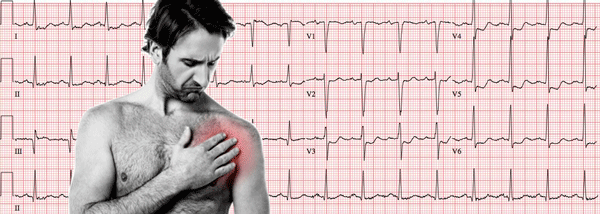Acute Coronary Syndromes
Acute coronary syndrome, within cardiovascular diseases, continues to be one of the main causes of death and its diagnosis in patients with chest pain remains one of the challenges of today 1.
Within acute coronary syndrome, two clinical entities have been differentiated, where the electrocardiogram is the best test to diagnose them.
Types of Acute Coronary Syndromes
- ST-segment elevation myocardial infarction (STEMI).
- Non–ST elevation acute coronary syndrome (NSTE-ACS).
Both entities share a similar base but differ, from the clinical point of view, in the level of associated severity and the need for urgent revascularization treatment of the ST-segment elevation myocardial infarction, while the absence of ST elevation (see NSTE-ACS), generally, entails a less aggressive treatment in its beginnings.
What Causes Acute Coronary Syndrome?
Both types of acute coronary syndromes are caused, generally, by the rupture of an atheromatous plaque with an associated thrombotic process, causing a partial or total occlusion of the coronary artery, producing different degrees of myocardial damage.
Depending on the myocardial damage, the alterations in the acute coronary syndrome electrocardiogram are provoked.
ST-Segment Elevation Myocardial Infarction:
A total occlusion of the coronary artery usually occurs, causing transmural myocardial ischemia and subsequently necrosis if not corrected.
Non-ST Elevation Acute Coronary Syndrome:
A partial occlusion of the coronary artery occurs, causing transient ischemia (unstable angina) or persistent ischemia at the endocardium level (non-ST-elevation myocardial infarction).
Clinical Presentation for Acute Coronary Syndrome
Chest pain is the classic symptom of acute coronary syndrome. It may appear with a physical effort or abruptly in the retrosternal region, of variable intensity (from simple tightness to very intense), oppressive, it usually radiates to the shoulder, left arm, jaw and back.
In the case of NSTE-ACS usually relieves itself alone or with nitrates, in STEMI it isn’t usually relieved, except with opioids or reperfusion. Chest pain may last from minutes to a few hours, and may be accompanied by sweating, nausea and "imminent death sensation".
In addition to pain, acute coronary syndromes may start with sudden dyspnea or with exertion, heart failure, epigastralgia or symptoms similar to digestive disorders.
They can also give very slight symptoms or none (silent infarction) and be diagnosed by their sequelae in a routine electrocardiogram.
Electrocardiogram in Acute Coronary Syndrome
ST-Segment Elevation Myocardial Infarction:
Related article: ST-segment elevation myocardial infarction.
On the electrocardiogram we found persistent ST elevation in more than one contiguous leads. The affected leads can guide us to the location of the infarction.
There is also a depression of the ST segment in unaffected leads (specular decrease).
In case of persistent elevation of the ST segment in the electrocardiogram, measures should be taken to ensure reperfusion treatment as soon as possible (fibrinolysis or angioplasty).
More information: ST-segment elevation myocardial infarction.
Acute Coronary Syndrome without ST elevation:
Related article: Non–ST elevation acute coronary syndrome.
The electrocardiogram in these acute coronary syndromes is more varied.
The most frequent finding is a depression of the ST segment in several contiguous leads. It is also frequent the presence of negative T waves accompanying the depression or without it.
Changes on the electrocardiogram usually accompany the symptoms and we can find normal EKG’s once the patient is asymptomatic.
More information: Non–ST elevation acute coronary syndrome.
References
If you Like it... Share it..






